#mysql_database
Text
Database Automation
Database automation with Ansible can significantly streamline the management and deployment of databases. Here are some specific subtopics and tasks you could explore within database automation:
1. Database Installation and Configuration
Task: Automate the installation of MySQL/PostgreSQL.
Playbooks:
Install database packages.
Initialize the database.
Configure the database server (e.g., set up users, configure authentication, modify configuration files).
2. Automating Database Backups
Task: Set up automated backups for databases.
Playbooks:
Create backup scripts for MySQL/PostgreSQL.
Schedule regular backups using cron jobs.
Store backups in remote locations (e.g., S3, FTP servers).
3. Database Replication Setup
Task: Automate the setup of database replication.
Playbooks:
Configure master and replica databases.
Set up replication users and permissions.
Handle failover configurations and testing.
4. Automating Database Migrations
Task: Manage database schema changes and migrations.
Playbooks:
Apply schema changes using tools like Alembic or Flyway.
Rollback migrations in case of failures.
Version control database schema changes.
5. Database Performance Tuning
Task: Optimize database performance automatically.
Playbooks:
Apply performance tuning parameters to configuration files.
Set up monitoring and alerting for performance metrics.
Automate index creation and maintenance tasks.
6. User and Permission Management
Task: Automate the creation and management of database users and permissions.
Playbooks:
Create database users with specific permissions.
Automate role assignments.
Implement security best practices for database access.
7. Automating Database Security
Task: Enhance database security through automation.
Playbooks:
Apply security patches and updates.
Configure firewalls and access controls.
Monitor and log database activity for suspicious behavior.
8. Disaster Recovery Planning
Task: Automate disaster recovery processes.
Playbooks:
Automate backup and restore procedures.
Test failover and recovery plans regularly.
Ensure data integrity and consistency across backups.
Sample Playbook for MySQL Installation and Basic Configuration
- name: Install and configure MySQL
hosts: database_servers
become: yes
vars:
mysql_root_password: "securepassword"
mysql_database: "myappdb"
mysql_user: "myappuser"
mysql_password: "myapppassword"
tasks:
- name: Install MySQL server
apt:
name: mysql-server
state: present
- name: Start MySQL service
service:
name: mysql
state: started
enabled: yes
- name: Set root password
mysql_user:
name: root
password: "{{ mysql_root_password }}"
login_user: root
login_password: ''
host_all: yes
when: ansible_os_family == "Debian"
- name: Remove anonymous users
mysql_user:
name: ''
host_all: yes
state: absent
- name: Remove test database
mysql_db:
name: test
state: absent
- name: Create application database
mysql_db:
name: "{{ mysql_database }}"
state: present
- name: Create application user
mysql_user:
name: "{{ mysql_user }}"
password: "{{ mysql_password }}"
priv: "{{ mysql_database }}.*:ALL"
state: present
- name: Apply basic security settings
mysql_variables:
- name: bind-address
value: 0.0.0.0
- name: max_connections
value: 150
This is a basic example, but it can be expanded to include more complex configurations and tasks as needed. You can also explore using Ansible roles for better organization and reusability of your playbooks.
For more details www.qcsdclabs.com
#linux#redhatcourses#information technology#containerorchestration#kubernetes#dockerswarm#aws#docker#container#containersecurity
0 notes
Text
dockerでWP入れてみたけどError establishing a database connectionが出たから
wp-config.phpをいじって解決した。
ネットに落ちてる参考文献をコピペしてdockerでWPインストール
↓
どうにもデータベース接続確立エラーが出てしまうしphpmyadminにもアイパス合ってるのにログインできない。
↓
・wp-config.phpのDB_NAME, DB_USER, DB_PASSWORD, DB_HOSTをdocker-compose.ymlと合わせる。
・DEBUGの記述を' 'からfalseかtrueに変更
define( 'WP_DEBUG', !!getenv_docker('WORDPRESS_DEBUG', ' ' ) );
↓
define( 'WP_DEBUG', !!getenv_docker('WORDPRESS_DEBUG', false) );
で、エラーが直った。
docker-compose.yml
version: '3.7'
services:
db:
platform: linux/x86_64
image: mysql:5.7
volumes:
# SQLデータを最新にする場合だけコメントイン
- ./docker/db/sqls:/docker-entrypoint-initdb.d #本番DBとデータを合わせる場合に記述
# - db_data:/var/lib/mysql
restart: always
environment:
MYSQL_ROOT_PASSWORD: root
MYSQL_DATABASE: db_name # DB名
MYSQL_USER: userdayo # DBユーザー名
MYSQL_PASSWORD: passdayo # DBパスワード
wordpress:
depends_on:
- db
image: wordpress:latest
container_name: wp
volumes:
- ./wp:/var/www/html
ports:
- "8000:80"
restart: always
environment:
WORDPRESS_DB_HOST: db:3306
WORDPRESS_DB_USER: userdayo # DBユーザー名
WORDPRESS_DB_PASSWORD: passdayo # DBパスワード
WORDPRESS_DB_NAME: db_name # DB名
WORDPRESS_DEBUG : 1 #デバッグモードON
phpmyadmin:
image: phpmyadmin:latest
container_name: phpmyadmin_ingrid
restart: always
depends_on:
- db
ports:
- 8888:80
volumes:
db_data:
0 notes
Photo
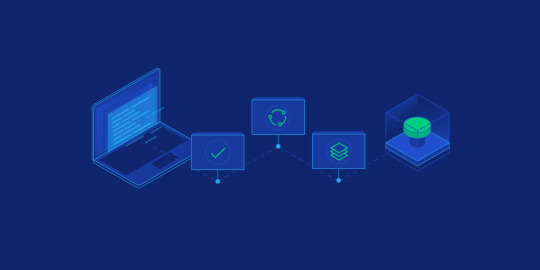
Deploy laravel project with docker swarm
We check three major step in this guide Setup laravel project with docker compose Deploy the stack to the swarm Create gitlab-ci Setup laravel project with docker compose we will explore the process of deploying a laravel project using docker swarm and setting up a CI/CD pipline to automate the deployment process. Now let’s start with containerize a laravel project with docker compose we need three separate service containers: An app service running PHP7.4-FPM; A db service running MySQL 5.7; An nginx service that uses the app service to parse PHP code Step 1. Set a env variable in project In root directory of project we have .env file now we need to update some variable DB_CONNECTION=mysql DB_HOST=db DB_PORT=3306 DB_DATABASE=experience DB_USERNAME=experience_user DB_PASSWORD=your-password Step 2. Setting up the application’s Docekrfile we need to build a custom image for the application container. We’ll create a new Dockerfile for that. Docker file FROM php:7.4-fpm # Install system dependencies RUN apt-get update && apt-get install -y \ git \ curl \ libpng-dev \ libonig-dev \ libxml2-dev \ zip \ unzip # Clear cache RUN apt-get clean && rm -rf /var/lib/apt/lists/* # Install PHP extensions RUN docker-php-ext-install pdo_mysql mbstring exif pcntl bcmath gd # Get latest Composer COPY --from=composer:latest /usr/bin/composer /usr/bin/composer # Set working directory WORKDIR /var/www Step 3. Setting up Nginx config and Database dump file In root directory create a new directory called docker-compose Now we need two other directories, a nginx directory and mysql directory So we have this two route in our project laravel-project/docker-compose/nginx/ laravel-project/docker-compose/mysql/ In nginx directory create a file called experience.conf we write nginx config in this file like: server { listen 80; index index.php index.html; error_log /var/log/nginx/error.log; access_log /var/log/nginx/access.log; root /var/www/public; location ~ \.php$ { try_files $uri =404; fastcgi_split_path_info ^(.+\.php)(/.+)$; fastcgi_pass app:9000; fastcgi_index index.php; include fastcgi_params; fastcgi_param SCRIPT_FILENAME $document_root$fastcgi_script_name; fastcgi_param PATH_INFO $fastcgi_path_info; } location / { try_files $uri $uri/ /index.php?$query_string; gzip_static on; } } In mysql directory create a file called init_db.init we write mysql initialization in this file like: DROP TABLE IF EXISTS `places`; CREATE TABLE `places` ( `id` bigint(20) unsigned NOT NULL AUTO_INCREMENT, `name` varchar(255) COLLATE utf8mb4_unicode_ci NOT NULL, `visited` tinyint(1) NOT NULL DEFAULT '0', PRIMARY KEY (`id`) ) ENGINE=InnoDB AUTO_INCREMENT=12 DEFAULT CHARSET=utf8mb4 COLLATE=utf8mb4_unicode_ci; INSERT INTO `places` (name, visited) VALUES ('Berlin',0),('Budapest',0),('Cincinnati',1),('Denver',0),('Helsinki',0),('Lisbon',0),('Moscow',1); Step 4. Creating a multi container with docker-compose We need a building three container that should share networks and data volumes. Ok so create a docker-compose file in root directory of project For craete a network for connecting services we define network in docker-compose file like this: networks: experience: driver: bridge App service: app: build: context: ./ dockerfile: Dockerfile image: travellist container_name: experience-app restart: unless-stopped working_dir: /var/www/ volumes: - ./:/var/www networks: - experience DB service: db: image: mysql:8.0 container_name: experience-db restart: unless-stopped environment: MYSQL_DATABASE: ${DB_DATABASE} MYSQL_ROOT_PASSWORD: ${DB_PASSWORD} MYSQL_PASSWORD: ${DB_PASSWORD} MYSQL_USER: ${DB_USERNAME} SERVICE_TAGS: dev SERVICE_NAME: mysql volumes: - ./docker-compose/mysql:/docker-entrypoint-initdb.d networks: - experience Nginx service: nginx: image: nginx:1.17-alpine container_name: experience-nginx restart: unless-stopped ports: - 8000:80 volumes: - ./:/var/www - ./docker-compose/nginx:/etc/nginx/conf.d networks: - experience So our docker-compose file be like this: version: "3.7" services: app: build: context: ./ dockerfile: Dockerfile image: travellist container_name: experience-app restart: unless-stopped working_dir: /var/www/ volumes: - ./:/var/www networks: - experience db: image: mysql:8.0 container_name: experience-db restart: unless-stopped environment: MYSQL_DATABASE: ${DB_DATABASE} MYSQL_ROOT_PASSWORD: ${DB_PASSWORD} MYSQL_PASSWORD: ${DB_PASSWORD} MYSQL_USER: ${DB_USERNAME} SERVICE_TAGS: dev SERVICE_NAME: mysql volumes: - ./docker-compose/mysql:/docker-entrypoint-initdb.d networks: - experience nginx: image: nginx:alpine container_name: experience-nginx restart: unless-stopped ports: - 8100:80 volumes: - ./:/var/www - ./docker-compose/nginx:/etc/nginx/conf.d/ networks: - experience networks: experience: driver: bridge Step 5. Running application with docker compose Now we can build the app image with this command: $ docker-compose build app When the build is finished, we can run the environment in background mode with: $ docker-compose up -d Output: Creating exprience-db ... done Creating exprience-app ... done Creating exprience-nginx ... done to show information about the state of your active services, run: $ docker-compose ps Well in these 5 simple steps, we have successfully ran our application. Now we have a docker-compose file for our application that needs for using in docker swarm. Let’s start Initialize docker swarm. After installing docker in your server *attention: To install Docker, be sure to use the official documentation install docker check docker information with this command: $ docker info You should see “swarm : inactive” in output For activate swarm in docker use this command: $ docker swarm init The docker engine targeted by this command becomes a manager in the newly created single-node swarm. What we want to use is the services of this docker swarm. We want to update our service like app with docker swarm, The advantage of updating our service in Docker Swarm is that there is no need to down the app service first, update the service, and then bring the service up. In this method, with one command, we can give the image related to the service to Docker and give the update command. Docker raises the new service without down the old service and slowly transfers the load from the old service to the new service. When running Docker Engine in swarm mode, we can use docker stack deploy to deploy a complete application stack to the swarm. The deploy command accepts a stack description in the form of a Compose file. So we down our docker compose with this command: $ docker-compose down And create our stack. ok if everything is ok until now take a rest Deploy the stack to the swarm $ docker stack deploy --compose-file docker-compose.yml For example : $ docker stack deploy --compose-file docker-compose.yml staging Probably you see this in output: Creating network staging_exprience Creating service staging_nginx failed to create service staging_nginx: Error response from daemon: The network staging_exprience cannot be used with services. Only networks scoped to the swarm can be used, such as those created with the overlay driver. This is because of “driver: bridge” for deploying your service in swarm mode you must use overlay driver for network if you remove this line in your docker compose file When the stack is being deployed this network will be create on overlay driver automatically. So our docker-compose file in network section be like this: networks: experience: And run upper command: $ docker stack deploy --compose-file docker-compose.yml staging For now you probably you see this error : failed to create service staging_nginx: Error response from daemon: The network staging_experience cannot be used with services. Only networks scoped to the swarm can be used, such as those created with the overlay driver. Get network list in your docker: $ docker network ls Output: NETWORK ID NAME DRIVER SCOPE 30f94ae1c94d staging_experience bridge local So your network has local scope yet because in first time deploy stack this network save in local scope and we must remove that by: $ docker network rm staging_experience After all this run command: $ docker stack deploy --compose-file docker-compose.yml staging Output: Creating network staging_experience Creating service staging_app Creating service staging_db Creating service staging_nginx Now get check stack by: $ docker stack ls Output: NAME SERVICES staging 3 And get service list by: $ docker service ls Output: If your REPLICAS is 0/1 something wrong is your service For checking service status run this command: $ docker service ps staging_app for example And for check detail of service run this command: $ docker service logs staging_app for example Output of this command show you what is problem of your service. And for updating your a service with an image the command you need is this: $ docker service update --image "<your-image>" "<name-of-your-service>" --force That's it your docker swarm is ready for zero down time deployment :))) Last step for have a complete process zero down time deployment is create pipeline in gitlab. Create gitlab-ci In this step we want create a pipeline in gitlab for build, test and deploy a project So we have three stage: stages: - Build - Test - Deploy Ok let’s clear what we need and what is going on in this step . We want update laravel project and push our change in gitlab create a new image of this changes and test that and after that log in to host server pull that updated image in server, and update service of project. For login to server we need define some variable in gitlab in your repository goto setting->CI/CD->VARIABLES Add variable Add this variables: CI_REGISTRY : https://registry.gitlab.com DOCKER_AUTH_CONFIG: { "auths": { "registry.gitlab.com": { "auth": "<auth-key>" } } } auth-key is base64 hash of “gitlab-username:gitlab-password” SSH_KNOWN_HOSTS: Like 192.168.1.1 ssh-rsa AAAAB3NzaC1yc2EAAAADAQABAAABgQCGUCqCK3hNl+4TIbh3+Af3np+v91AyW4+BxXRtHBC2Y/uPJXF2jdR6IHlSS/0RFR3hOY+8+5a/r8O1O9qTPgxG8BSIm9omb8YxF2c4Sz/USPDK3ld2oQxbBg5qdhRN28EvRbtN66W3vgYIRlYlpNyJA+b3HQ/uJ+t3UxP1VjAsKbrBRFBth845RskSr1V7IirMiOh7oKGdEfXwlOENxOI7cDytxVR7h3/bVdJdxmjFqagrJqBuYm30 You can see how generate ssh key in this post: generate sshkey SSH_PRIVATE_KEY: SSH_REMOTE_HOST: root@ This is your variables in gitlab. So let’s back to gitlab-ci In root directory of project create a new file .gitlab-ci.yml and set build stage set test stage And in the last set deploy stage like: stages: - Build - Test - Deploy variables: IMAGE_TAG: $CI_REGISTRY_IMAGE:$CI_COMMIT_REF_SLUG-$CI_COMMIT_SHORT_SHA build: stage: Build image: docker:20.10.16 services: - docker:dind script: - docker login -u $CI_REGISTRY_USER -p $CI_REGISTRY_PASSWORD $CI_REGISTRY - docker build --pull -f Dockerfile -t $IMAGE_TAG . - docker push $IMAGE_TAG preparation: stage: Test image: $IMAGE_TAG needs: - build script: - composer install artifacts: expire_in: 1 day paths: - ./vendor cache: key: ${CI_COMMIT_REF_SLUG}-composer paths: - ./vendor unit-test: stage: Test image: $IMAGE_TAG services: - name: mysql:8 alias: mysql-test needs: - preparation variables: APP_KEY: ${APP_KEY} MYSQL_ROOT_PASSWORD: ${MYSQL_ROOT_PASSWORD} MYSQL_DATABASE: ${MYSQL_DATABASE} DB_HOST: ${DB_HOST} DB_USERNAME: ${DB_USERNAME} DB_PASSWORD: ${DB_PASSWORD} script: - php vendor/bin/phpunit staging-deploy: stage: Deploy extends: - .deploy-script variables: APP: "stackdemo_app" STACK: "travellist-staging" only: - develop needs: - unit-test environment: name: stage .remote-docker: variables: DOCKER_HOST: ssh://${SSH_REMOTE_HOST} image: docker:20.10.16 before_script: - eval $(ssh-agent -s) - echo $IMAGE_TAG - echo "$SSH_PRIVATE_KEY" | tr -d '\r' | ssh-add - - mkdir -p ~/.ssh - chmod 700 ~/.ssh - echo "HOST *" > ~/.ssh/config - echo "StrictHostKeyChecking no" >> ~/.ssh/config - echo -n $CI_REGISTRY_PASSWORD | docker login -u $CI_REGISTRY_USER --password-stdin $CI_REGISTRY .deploy-script: extends: - .remote-docker script: - cp $develop_config /root/project/core - docker pull $IMAGE_TAG - docker service update --image "$IMAGE_TAG" "$APP" --force dependencies: [] Change something in your project and push to gitlab and wait for it To see all pipeline pass like this : And this is beautiful.
https://dev.to/holyfalcon/deploy-laravel-project-with-docker-swarm-5oi
0 notes
Text
Periodic "Lost connection to MySQL server during query" after Dockerizing Flask Web App
I have a Flask web app that used to run on a standalone server using the following:
Flask/SQLAlchemy
MariaDB
uwsgi
nginx
On the stand alone server this application ran fine.
I have since "dockerized" this application across two containers:
uwsgi-nginx-flask
MariaDB
Every since dockerizing I occasionally get this error (entire traceback posted at the end):
Lost connection to MySQL server during query
The MariaDB log shows the following errors with verbose logging:
2020-05-10 18:35:32 130 [Warning] Aborted connection 130 to db: 'flspection2' user: 'fl-server' host: '172.19.0.1' (Got an error reading communication packets)2020-05-10 18:45:34 128 [Warning] Aborted connection 128 to db: 'flspection2' user: 'fl-server' host: '172.19.0.1' (Got timeout reading communication packets)
This is experienced by the user as a 502 Bad Gateway. If the user refreshes the page, this will often solve the problem. This issue arises at random. I have not been able to reproduce it at will, but over time it will inevitably show up.
What is causing this and how can I solve it?
What I've done:
Verified that the MariaDB container has a timeout is 28800. I've seen the error occur much sooner than 28800 seconds after restarting all the containers, so I don't think it is actually a timeout issue.
Set pool_recycle option to 120
Verified that Flask-SQLAlchemy is using a scoped_session which should avoid these timing out issues.
Changed network_mode to default per a comment. This did not solve the problem.
My thoughts are that it acts like the connection between flask and the database is unreliable, but as docker containers running on the same host, shouldn't that be quite reliable?
Relevant code:
database.py
from flask_sqlalchemy import SQLAlchemydb = SQLAlchemy()
config.py
class Config: ... SQLALCHEMY_DATABASE_URI = 'mysql+pymysql://username:[email protected]/database?charset=utf8mb4' SQLALCHEMY_TRACK_MODIFICATIONS = False SQLALCHEMY_ENGINE_OPTIONS = { 'pool_recycle': 120 } ...
docker-compose.yml
version: "3.7"services: db: restart: "always" build: ./docker/db volumes: - "~/db:/var/lib/mysql" environment: MYSQL_ROOT_PASSWORD: "password" MYSQL_DATABASE: "database" MYSQL_USER: "user" MYSQL_PASSWORD: "password" ports: - '3306:3306' nginx-uwsgi-flask: restart: "always" depends_on: - "db" build: context: . dockerfile: ./docker/nginx-uwsgi-flask/Dockerfile volumes: - "~/data/fileshare:/fileshare" ports: - "80:80" - "443:443" network_mode: "host"
traceback
Traceback (most recent call last): File "/usr/local/lib/python3.6/site-packages/sqlalchemy/engine/base.py", line 1193, in _execute_context context) File "/usr/local/lib/python3.6/site-packages/sqlalchemy/engine/default.py", line 509, in do_execute cursor.execute(statement, parameters) File "/usr/local/lib/python3.6/site-packages/pymysql/cursors.py", line 170, in execute result = self._query(query) File "/usr/local/lib/python3.6/site-packages/pymysql/cursors.py", line 328, in _query conn.query(q) File "/usr/local/lib/python3.6/site-packages/pymysql/connections.py", line 517, in query self._affected_rows = self._read_query_result(unbuffered=unbuffered) File "/usr/local/lib/python3.6/site-packages/pymysql/connections.py", line 732, in _read_query_result result.read() File "/usr/local/lib/python3.6/site-packages/pymysql/connections.py", line 1075, in read first_packet = self.connection._read_packet() File "/usr/local/lib/python3.6/site-packages/pymysql/connections.py", line 657, in _read_packet packet_header = self._read_bytes(4) File "/usr/local/lib/python3.6/site-packages/pymysql/connections.py", line 707, in _read_bytes CR.CR_SERVER_LOST, "Lost connection to MySQL server during query")pymysql.err.OperationalError: (2013, 'Lost connection to MySQL server during query')The above exception was the direct cause of the following exception:Traceback (most recent call last): File "/usr/local/lib/python3.6/site-packages/flask/app.py", line 2292, in wsgi_app response = self.full_dispatch_request() File "/usr/local/lib/python3.6/site-packages/flask/app.py", line 1815, in full_dispatch_request rv = self.handle_user_exception(e) File "/usr/local/lib/python3.6/site-packages/flask/app.py", line 1718, in handle_user_exception reraise(exc_type, exc_value, tb) File "/usr/local/lib/python3.6/site-packages/flask/_compat.py", line 35, in reraise raise value File "/usr/local/lib/python3.6/site-packages/flask/app.py", line 1813, in full_dispatch_request rv = self.dispatch_request() File "/usr/local/lib/python3.6/site-packages/flask/app.py", line 1799, in dispatch_request return self.view_functions[rule.endpoint](**req.view_args) File "/usr/local/lib/python3.6/site-packages/flask_user/decorators.py", line 132, in decorator allowed = _is_logged_in_with_confirmed_email(user_manager) File "/usr/local/lib/python3.6/site-packages/flask_user/decorators.py", line 17, in _is_logged_in_with_confirmed_email if user_manager.call_or_get(current_user.is_authenticated): File "/usr/local/lib/python3.6/site-packages/werkzeug/local.py", line 347, in __getattr__ return getattr(self._get_current_object(), name) File "/usr/local/lib/python3.6/site-packages/werkzeug/local.py", line 306, in _get_current_object return self.__local() File "/usr/local/lib/python3.6/site-packages/flask_login/utils.py", line 26, in <lambda> current_user = LocalProxy(lambda: _get_user()) File "/usr/local/lib/python3.6/site-packages/flask_login/utils.py", line 335, in _get_user current_app.login_manager._load_user() File "/usr/local/lib/python3.6/site-packages/flask_login/login_manager.py", line 359, in _load_user return self.reload_user() File "/usr/local/lib/python3.6/site-packages/flask_login/login_manager.py", line 321, in reload_user user = self.user_callback(user_id) File "/usr/local/lib/python3.6/site-packages/flask_user/user_manager.py", line 130, in load_user_by_user_token user = self.db_manager.UserClass.get_user_by_token(user_token) File "/usr/local/lib/python3.6/site-packages/flask_user/user_mixin.py", line 51, in get_user_by_token user = user_manager.db_manager.get_user_by_id(user_id) File "/usr/local/lib/python3.6/site-packages/flask_user/db_manager.py", line 179, in get_user_by_id return self.db_adapter.get_object(self.UserClass, id=id) File "/usr/local/lib/python3.6/site-packages/flask_user/db_adapters/sql_db_adapter.py", line 48, in get_object return ObjectClass.query.get(id) File "/usr/local/lib/python3.6/site-packages/sqlalchemy/orm/query.py", line 924, in get ident, loading.load_on_pk_identity) File "/usr/local/lib/python3.6/site-packages/sqlalchemy/orm/query.py", line 1007, in _get_impl return db_load_fn(self, primary_key_identity) File "/usr/local/lib/python3.6/site-packages/sqlalchemy/orm/loading.py", line 250, in load_on_pk_identity return q.one() File "/usr/local/lib/python3.6/site-packages/sqlalchemy/orm/query.py", line 2954, in one ret = self.one_or_none() File "/usr/local/lib/python3.6/site-packages/sqlalchemy/orm/query.py", line 2924, in one_or_none ret = list(self) File "/usr/local/lib/python3.6/site-packages/sqlalchemy/orm/query.py", line 2995, in __iter__ return self._execute_and_instances(context) File "/usr/local/lib/python3.6/site-packages/sqlalchemy/orm/query.py", line 3018, in _execute_and_instances result = conn.execute(querycontext.statement, self._params) File "/usr/local/lib/python3.6/site-packages/sqlalchemy/engine/base.py", line 948, in execute return meth(self, multiparams, params) File "/usr/local/lib/python3.6/site-packages/sqlalchemy/sql/elements.py", line 269, in _execute_on_connection return connection._execute_clauseelement(self, multiparams, params) File "/usr/local/lib/python3.6/site-packages/sqlalchemy/engine/base.py", line 1060, in _execute_clauseelement compiled_sql, distilled_params File "/usr/local/lib/python3.6/site-packages/sqlalchemy/engine/base.py", line 1200, in _execute_context context) File "/usr/local/lib/python3.6/site-packages/sqlalchemy/engine/base.py", line 1413, in _handle_dbapi_exception exc_info File "/usr/local/lib/python3.6/site-packages/sqlalchemy/util/compat.py", line 265, in raise_from_cause reraise(type(exception), exception, tb=exc_tb, cause=cause) File "/usr/local/lib/python3.6/site-packages/sqlalchemy/util/compat.py", line 248, in reraise raise value.with_traceback(tb) File "/usr/local/lib/python3.6/site-packages/sqlalchemy/engine/base.py", line 1193, in _execute_context context) File "/usr/local/lib/python3.6/site-packages/sqlalchemy/engine/default.py", line 509, in do_execute cursor.execute(statement, parameters) File "/usr/local/lib/python3.6/site-packages/pymysql/cursors.py", line 170, in execute result = self._query(query) File "/usr/local/lib/python3.6/site-packages/pymysql/cursors.py", line 328, in _query conn.query(q) File "/usr/local/lib/python3.6/site-packages/pymysql/connections.py", line 517, in query self._affected_rows = self._read_query_result(unbuffered=unbuffered) File "/usr/local/lib/python3.6/site-packages/pymysql/connections.py", line 732, in _read_query_result result.read() File "/usr/local/lib/python3.6/site-packages/pymysql/connections.py", line 1075, in read first_packet = self.connection._read_packet() File "/usr/local/lib/python3.6/site-packages/pymysql/connections.py", line 657, in _read_packet packet_header = self._read_bytes(4) File "/usr/local/lib/python3.6/site-packages/pymysql/connections.py", line 707, in _read_bytes CR.CR_SERVER_LOST, "Lost connection to MySQL server during query")sqlalchemy.exc.OperationalError: (pymysql.err.OperationalError) (2013, 'Lost connection to MySQL server during query') [SQL: 'SELECT user.is_active AS user_is_active, user.id AS user_id, user.username AS user_username, user.password AS user_password, user.reset_password_token AS user_reset_password_token, user.email AS user_email, user.email_confirmed_at AS user_email_confirmed_at, user.first_name AS user_first_name, user.last_name AS user_last_name \nFROM user \nWHERE user.id = %(param_1)s'] [parameters: {'param_1': 13}] (Background on this error at: http://sqlalche.me/e/e3q8)
https://codehunter.cc/a/flask/periodic-lost-connection-to-mysql-server-during-query-after-dockerizing-flask-web-app
0 notes
Text
Semaphore is an open-source tool that provides a beautiful web interface to run ansible playbooks. This tool written in Go languages can be installed on Windows, Linux(x64, ARM, ARM64), and macOS systems. This tool comes in handy when your project has grown and you do not need to deploy it from the command line.
The amazing features associated with Semaphore Ansible web UI are:
Pure Go allows one to cross-compile it for several platforms. This is the main reason why it is preferred by DevOps.
It allows one to run playbooks by schedule
View detailed logs of any runs at any time
Group playbooks to projects
Easily manage environments, inventories, repositories, and access keys.
You can use it to build, deploy and roll back if needed from the browser.
Get notified about playbook runs
It allows one to grant other users privileges to run playbooks
In addition to the above features, Semaphore supports MySQL, PostgreSQL, and BoltDB. There are many ways one can install and use the Semaphore Ansible web UI. These include using Snap, package managers, binary files e.t.c.
This guide offers a deep illustration of how to run the Semaphore Ansible web UI in Docker Container.
Before you Begin.
This guide requires one to have both the Docker engine and docker-compose installed. Docker can be installed on Linux systems using the aid from the guide below.
How To Install Docker CE on Linux Systems
Once the Docker Engine has been installed, add your system user to the Docker group with the command:
sudo usermod -aG docker $USER
newgrp docker
Proceed and install Docker-compose with the dedicated guide:
How To Install Docker Compose on Linux
Verify the installation.
$ docker-compose version
Docker Compose version v2.4.1
Now start and enable docker to run on system boot.
sudo systemctl start docker && sudo systemctl enable docker
Step 1 – Provision the Semaphore Container.
The container will contain two parts, i.e
Database – (MySQL) for data storage
Ansible Semaphore(latest image)
Create the docker-compose file using the below commands:
mkdir semaphore && cd semaphore
vim docker-compose.yml
Add the below lines to the file replacing variables where needed.
version: '2'
services:
mysql:
ports:
- 3306:3306
image: mysql:5.6
container_name: mysql
hostname: mysql
environment:
MYSQL_RANDOM_ROOT_PASSWORD: 'yes'
MYSQL_DATABASE: semaphore_db
MYSQL_USER: semaphore_user
MYSQL_PASSWORD: StrongPassw0rd
semaphore:
ports:
- 3000:3000
image: ansiblesemaphore/semaphore:latest
container_name: semaphore
environment:
SEMAPHORE_DB_USER: semaphore_user
SEMAPHORE_DB_PASS: StrongPassw0rd
SEMAPHORE_DB_HOST: mysql
SEMAPHORE_DB_PORT: 3306
SEMAPHORE_DB: semaphore_db
SEMAPHORE_PLAYBOOK_PATH: /tmp/semaphore/
SEMAPHORE_ADMIN_PASSWORD: AdminPassword
SEMAPHORE_ADMIN_NAME: admin
SEMAPHORE_ADMIN_EMAIL: [email protected]
SEMAPHORE_ADMIN: admin
SEMAPHORE_ACCESS_KEY_ENCRYPTION: MflCLIUF5bn6Lgkuwy4BoAdIFhoZ4Ief2oocXmuZSjs=
depends_on:
- mysql
In the file, replace:
MYSQL_USER and SEMAPHORE_DB_USER with the desired database user.
MYSQL_PASSWORD and SEMAPHORE_DB_PASS with the database password for the user
SEMAPHORE_ADMIN_PASSWORD with the password for the admin user for Semaphore Ansible web UI
SEMAPHORE_ACCESS_KEY_ENCRYPTION with the key to encrypt the access keys in your database. This key encryption can be generated using the command:
$ head -c32 /dev/urandom | base64
MflCLIUF5bn6Lgkuwy4BoAdIFhoZ4Ief2oocXmuZSjs=
Step 2 – Run Semaphore Ansible web UI in Docker Container
Now with the container provisioned, we can run Semaphore using the command:
docker-compose up -d
Execution output:
[+] Running 19/19
⠿ semaphore Pulled 21.2s
⠿ 4e9f2cdf4387 Pull complete 0.9s
⠿ 8eba5c7ef78e Pull complete 1.3s
⠿ 4b2e0cc6dd21 Pull complete 18.3s
⠿ 5d4e24327603 Pull complete 18.4s
⠿ b53de92b8d36 Pull complete 18.9s
⠿ 8ada155f2bd8 Pull complete 19.2s
⠿ mysql Pulled 19.0s
⠿ 35b2232c987e Pull complete 5.1s
⠿ fc55c00e48f2 Pull complete 5.5s
⠿ 0030405130e3 Pull complete 6.2s
⠿ e1fef7f6a8d1 Pull complete 6.9s
⠿ 1c76272398bb Pull complete 7.6s
⠿ f57e698171b6 Pull complete 9.4s
⠿ f5b825b269c0 Pull complete 9.8s
⠿ dcb0af686073 Pull complete 10.4s
⠿ 27bbfeb886d1 Pull complete 15.6s
⠿ 6f70cc868145 Pull complete 15.9s
⠿ 1f6637f4600d Pull complete 16.3s
[+] Running 3/3
⠿ Network semaphore_default Created 0.3s
⠿ Container semaphore-mysql-1 Started 1.6s
⠿ Container semaphore-semaphore-1 Started 1.5s
Verify if the containers are running with services exposed.
$ docker ps
CONTAINER ID IMAGE COMMAND CREATED STATUS PORTS NAMES
ea51aeb59791 ansiblesemaphore/semaphore:latest "/sbin/tini -- /usr/…" 17 seconds ago Up 15 seconds 0.0.0.0:3000->3000/tcp, :::3000->3000/tcp semaphore
abf873ba28c2 mysql:5.6 "docker-entrypoint.s…" 18 seconds ago Up 16 seconds 0.0.0.0:3306->3306/tcp, :::3306->3306/tcp mysql
Step 3 – Secure Semaphore Ansible web UI with SSL certificates.
This guide demonstrates how to secure the Semaphore Ansible web UI with Let’s Encrypt and Self-signed certificates.
Begin by installing the Nginx web server.
##On RHEL/CentOS/Rocky Linux 8
sudo yum install nginx
##On Debian/Ubuntu
sudo apt install nginx
Proceed and create the virtual host file for Semaphore.
sudo vim /etc/nginx/conf.d/semaphore.conf
In the opened file, add the lines below:
upstream semaphore
server 127.0.0.1:3000;
server
listen 80;
server_name semaphore.example.com;
client_max_body_size 0;
chunked_transfer_encoding on;
location /
proxy_pass http://semaphore/;
proxy_set_header Host $http_host;
proxy_set_header X-Real-IP $remote_addr;
proxy_set_header X-Forwarded-For $proxy_add_x_forwarded_for;
proxy_set_header X-Forwarded-Proto $scheme;
proxy_buffering off;
proxy_request_buffering off;
location /api/ws
proxy_pass http://semaphore/api/ws;
proxy_http_version 1.1;
proxy_set_header Upgrade $http_upgrade;
proxy_set_header Connection "upgrade";
proxy_set_header Origin "";
Save the file and proceed to generate SSL certificates.
1. Secure Semaphore Ansible web UI with Let’s Encrypt SSL.
Let’s Encrypt is used to issue free trusted SSL certificates to a domain name for free. To be able to generate the SSL certificates, install the required packages.
##On RHEL 8/CentOS 8/Rocky Linux 8/Fedora
sudo dnf install https://dl.fedoraproject.org/pub/epel/epel-release-latest-8.noarch.rpm
sudo dnf install certbot python3-certbot-nginx
##On Debian/Ubuntu
sudo apt install certbot python3-certbot-nginx
Issue SSL certificates with the command:
sudo certbot --nginx
Proceed as below:
Saving debug log to /var/log/letsencrypt/letsencrypt.log
Enter email address (used for urgent renewal and security notices)
(Enter 'c' to cancel): Enter a valid Email address here
- - - - - - - - - - - - - - - - - - - - - - - - - - - - - - - - - - - - - - - -
Please read the Terms of Service at
https://letsencrypt.org/documents/LE-SA-v1.2-November-15-2017.pdf. You must
agree in order to register with the ACME server. Do you agree?
- - - - - - - - - - - - - - - - - - - - - - - - - - - - - - - - - - - - - - - -
(Y)es/(N)o: y
- - - - - - - - - - - - - - - - - - - - - - - - - - - - - - - - - - - - - - - -
Would you be willing, once your first certificate is successfully issued, to
share your email address with the Electronic Frontier Foundation, a founding
partner of the Let's Encrypt project and the non-profit organization that
develops Certbot? We'd like to send you email about our work encrypting the web,
EFF news, campaigns, and ways to support digital freedom.
- - - - - - - - - - - - - - - - - - - - - - - - - - - - - - - - - - - - - - - -
(Y)es/(N)o: y
Account registered.
Which names would you like to activate HTTPS for?
- - - - - - - - - - - - - - - - - - - - - - - - - - - - - - - - - - - - - - - -
1: semaphore.example.com
- - - - - - - - - - - - - - - - - - - - - - - - - - - - - - - - - - - - - - - -
Select the appropriate numbers separated by commas and/or spaces, or leave input
blank to select all options shown (Enter 'c' to cancel): 1
Requesting a certificate for semaphore.example.com
Performing the following challenges:
http-01 challenge for semaphore.example.com
....
Successfully received certificate.
Certificate is saved at: a2enmod ssl
That is it, you will have your certificate added to your Nginx config file.
2. Secure Semaphore Ansible web UI with Self-signed Certificates.
In case you do not have an FQDN, you can generate Self-signed Certificates for your domain name/IP Address as below.
Create a config file to be used to generate the certificates.
$ vim semaphore_ssl.conf
[req]
default_bits = 2048
default_keyfile = semaphore_ssl.key
distinguished_name = req_distinguished_name
req_extensions = req_ext
x509_extensions = v3_ca
[req_distinguished_name]
countryName = Country Name (2 letter code)
countryName_default = KE
stateOrProvinceName = State or Province Name (full name)
stateOrProvinceName_default = Nairobi
localityName = Locality Name (eg, city)
localityName_default = Nairobi
organizationName = Organization Name (eg, company)
organizationName_default = Computingforgeeks
organizationalUnitName = organizationalunit
organizationalUnitName_default = Development
commonName = Common Name (e.g. server FQDN or YOUR name)
commonName_default = Your_IP-Address
commonName_max = 64
[req_ext]
subjectAltName = @alt_names
[v3_ca]
subjectAltName = @alt_names
[alt_names]
DNS.1 = localhost
DNS.2 = Your_IP-Address
Generate the SSL certificates using OpenSSL as below:
openssl req -x509 -nodes -days 365 -newkey rsa:2048 -keyout semaphore_ssl.key -out semaphore_ssl.crt -config semaphore_ssl.conf
Press enter to the end and you will have an SSL certificate pair generated. Copy the certificates to the /etc/ssl/certs directory.
sudo cp semaphore_ssl.crt /etc/ssl/certs/semaphore_ssl.crt
sudo mkdir -p /etc/ssl/private/
sudo cp semaphore_ssl.key /etc/ssl/private/semaphore_ssl.key
Now edit your Nginx config file as below.
sudo vim /etc/nginx/conf.d/semaphore.conf
Make the below changes to the file.
upstream semaphore
server 127.0.0.1:3000;
server
server_name semaphore.example.com;
client_max_body_size 0;
chunked_transfer_encoding on;
location /
proxy_pass http://semaphore/;
proxy_set_header Host $http_host;
proxy_set_header X-Real-IP $remote_addr;
proxy_set_header X-Forwarded-For $proxy_add_x_forwarded_for;
proxy_set_header X-Forwarded-Proto $scheme;
proxy_buffering off;
proxy_request_buffering off;
location /api/ws
proxy_pass http://semaphore/api/ws;
proxy_http_version 1.1;
proxy_set_header Upgrade $http_upgrade;
proxy_set_header Connection "upgrade";
proxy_set_header Origin "";
listen 443 ssl; # managed by Certbot
ssl_certificate /etc/ssl/certs/semaphore_ssl.crt;
ssl_certificate_key /etc/ssl/private/semaphore_ssl.key;
server
if ($host = semaphore.example.com)
return 301 https://$host$request_uri;
listen 80;
server_name semaphore.example.com;
return 404;
Save the file and restart Nginx.
sudo systemctl restart nginx
Step 4 – Access Semaphore Ansible web UI
At this point, you will have Semaphore accessible via HTTPS. Allow HTTP and HTTPS through the firewall.
##For Firewalld
sudo firewall-cmd --add-service=http --permanent
sudo firewall-cmd --add-service=https --permanent
sudo firewall-cmd --reload
##For UFW
sudo ufw allow http
sudo ufw allow https
Now proceed and access the Semaphore Ansible web UI using the URL https://doamin_name
Login using the admin user and password created. Proceed and create a project.
Once a project has been created, the dashboard will be granted as below.
Create a task template. A template is used to define how ansible will run the playbook. Creating a new template requires one to provide:
Inventory
Playbook filename
Playbook repository
Environment
Vault password file
Extra CLI arguments e.t.c
The task template can be:
Task
Build
Deploy
A task simply runs the specified playbook.
The build template is used to create artifacts. Here, you need to specify the start version of the artifact.
The deploy template now deploys artifacts to the server. This is normally associated with the build template.
Step 5 – Manage the Containers.
In this guide, we have two containers that can be managed using the docker start and stop commands below:
##To stop
docker stop semaphore
docker stop mysql
##To start
docker start semaphore
docker start mysql
##To delete
docker rm semaphore
docker rm mysql
These containers can be managed as system services. To be able to achieve this, we will create service files for each container.
For MYSQL
$ sudo vim /etc/systemd/system/mysql_container.service
[Unit]
Description=MySQL container
[Service]
Restart=always
ExecStart=/usr/bin/docker start -a mysql
ExecStop=/usr/bin/docker stop -t 2 mysql
[Install]
WantedBy=local.target
For Semaphore.
$ sudo vim /etc/systemd/system/semaphore_container.service
[Unit]
Description=Semaphore container
[Service]
Restart=always
ExecStart=/usr/bin/docker start -a semaphore
ExecStop=/usr/bin/docker stop -t 2 semaphore
[Install]
WantedBy=local.target
Reload the system daemon.
sudo systemctl daemon-reload
Start and enable the container services to run on boot.
##For MySQL
sudo systemctl start mysql_container
sudo systemctl enable mysql_container
##For Semaphore
sudo systemctl start semaphore_container
sudo systemctl enable semaphore_container
Check the status of the service:
$ systemctl status mysql_container semaphore_container
● mysql_container.service - MySQL container
Loaded: loaded (/etc/systemd/system/mysql_container.service; enabled; vendor preset: disabled)
Active: active (running) since Thu 2022-04-28 10:48:47 EDT; 1min 11s ago
Main PID: 8906 (docker)
Tasks: 5 (limit: 23682)
Memory: 38.7M
CGroup: /system.slice/mysql_container.service
└─8906 /usr/bin/docker start -a mysql
● semaphore_container.service - Semaphore container
Loaded: loaded (/etc/systemd/system/semaphore_container.service; enabled; vendor preset: disabled)
Active: active (running) since Thu 2022-04-28 10:49:09 EDT; 49s ago
Main PID: 8957 (docker)
Tasks: 6 (limit: 23682)
Memory: 19.4M
CGroup: /system.slice/semaphore_container.service
└─8957 /usr/bin/docker start -a semaphore
That is it!
Now you can easily deploy applications/services using semaphore Ansible web UI. I hope this was helpful
0 notes
Photo

Download ShoutOutNow - Codeigniter on Codecanyon [wpsm_ads1]
Description ShoutOutNow - Codeigniter :
Download ShoutOutNow - Codeigniter. The theme releases on Monday 23rd January 2017 By The author Junusme on Codecanyon. It’s makes use of with admin,bootstrap 4,codeigniter,login,fashionable,mysql database,php,register,responsive. Item Title: ShoutOutNow - Codeigniter Category: php-scripts/miscellaneous Price: $8 Author: Junusme Published Date: Monday 23rd January 2017 07:10:37 AM More Info / DownloadDemo [wpsm_ads2]
Have the chance to get a shoutout free of charge. This codeigniter script refreshes each hour and choose a random consumer to get a free shoutout.
http://sefainvest.com/webdesign/shoutoutnow/
Email: [email protected]
Password: admin
[wpsm_ads1] More Info / DownloadDemo #ShoutOutNow #Codeigniter
#admin#All_Code_amp_plugin#bootstrap_4#Code_amp_plugin_Weekly_bestsellers#codeigniter#login#modern#mysql_database#php#PHP_scripts#PHP_scripts_Weekly_bestsellers#register#responsive#Weekly_bestsellers
0 notes
Photo

MySQL Workbench (Download and Installation)
0 notes
Text
github actions & docker-compose
何をしたか
ciでmysqlを使いたかった。
サービスコンテナのmysqlを利用したら文字コードで引っかかりまくって、設定もうまいこと行かなかったので、dockerを使う。
ディレクトリ構造は以下な感じ。
// tree . ├── .github │ └── workflows │ └── integrage.yml ├── db │ └── mysql │ └── init.d │ ├── ddl.sql │ └── dml.sql └── docker-compose.ci.yml
ci用のdocker-composeは以下で定義。
// docker-compose.ci.yml version: '3.5' services: db: image: mysql:5.7 container_name: sample_db_test environment: MYSQL_ROOT_PASSWORD: root MYSQL_DATABASE: sample MYSQL_USER: worker MYSQL_PASSWORD: password TZ: 'Asia/Tokyo' command: mysqld --character-set-server=utf8mb4 --collation-server=utf8mb4_unicode_ci volumes: - ./db/mysql/init.d:/docker-entrypoint-initdb.d ports: - 3306:3306 restart: always
github actionsのworkflowは以下。一部省略してます。
// .github/workflows/integrate.yml name: integrate on: ... env: ... jobs: static-check: name: StaticCheck runs-on: ubuntu-latest steps: ... test: name: Test runs-on: ubuntu-latest needs: [ static-check ] steps: ... # set up db - name: SetUp db run: | docker-compose -f docker-compose.ci.yml up -d sleep 15 # 起動待ち ... # Run test - name: Test run: | go test -v ./...
1 note
·
View note
Photo
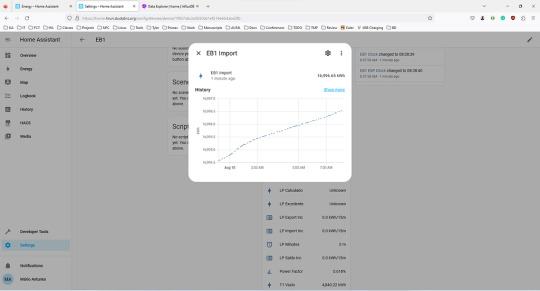
Energy dashboard missing some bars
Recently I acquired a sensor for the electricity meter. The sensor page is in PT, but is a tasmota that was adjusted to the meters used in Portugal. It is connected through MQTT and I have the values in Home Assistant and the database: However, the energy dashboard has a strange behaviour: There are mentions of similar issues, but all appear to fix themselves after one update or by changing the browser. HomeAssistant is being deployed in an RPI4 with the following docker-compose: version: '3' services: homeassistant: container_name: homeassistant image: "ghcr.io/home-assistant/home-assistant:stable" restart: unless-stopped environment: - TZ=Europe/Lisbon volumes: - ./config/:/config - /etc/localtime:/etc/localtime:ro privileged: true network_mode: host depends_on: - mosquitto - mariadb - influxdb mosquitto: image: eclipse-mosquitto container_name: mosquitto volumes: - ./mosquitto:/mosquitto restart: unless-stopped network_mode: host mariadb: container_name: mariadb image: mariadb restart: unless-stopped ports: - "13306:3306/tcp" # So we can access the WebUI environment: - TZ=Europe/Lisbon - MYSQL_ROOT_PASSWORD=${MYSQL_ROOT_PASSWORD} - MYSQL_DATABASE=${MYSQL_HA_DATABASE} - MYSQL_USER=${MYSQL_HA_USER} - MYSQL_PASSWORD=${MYSQL_HA_PASSWORD} volumes: - ./mariadb/data:/var/lib/mysql - ./mariadb/config/:/etc/mysql/conf.d influxdb: container_name: influxdb image: influxdb restart: unless-stopped ports: - "8086:8086/tcp" # So we can access the WebUI environment: - TZ=Europe/Lisbon - DOCKER_INFLUXDB_INIT_MODE=setup - DOCKER_INFLUXDB_INIT_USERNAME=${INFLUXDB_USER} - DOCKER_INFLUXDB_INIT_PASSWORD=${INFLUXDB_PASSWORD} - DOCKER_INFLUXDB_INIT_ORG=${INFLUXDB_ORG} - DOCKER_INFLUXDB_INIT_BUCKET=${INFLUXDB_BUCKET} volumes: - ./influxdb/data:/var/lib/influxdb2 - ./influxdb/config/:/etc/influxdb2 ulimits: nofile: soft: 32768 hard: 32768 And the configuration file for home assistant is the following: # Loads default set of integrations. Do not remove. default_config: # Text to speech tts: - platform: google_translate automation: !include automations.yaml script: !include scripts.yaml scene: !include scenes.yaml http: use_x_forwarded_for: true trusted_proxies: - 127.0.0.1 - ::1 - 192.168.1.0/24 recorder: db_url: !secret mariadb purge_keep_days: 10 # default history: influxdb: api_version: 2 ssl: false host: 127.0.0.1 port: 8086 token: !secret influxdb_token organization: !secret influx_org bucket: homeassistant tags: source: HomeAssistant tags_attributes: - friendly_name default_measurement: units ignore_attributes: - icon exclude: # Customise to fit your needs entities: - zone.home domains: - persistent_notification - person Since the sensor values are in the database, I don’t think the issue is in the deployment. I also have no errors in the logs, nor issues in the statistics dev menu. Any idea? 2 posts - 2 participants Read full topic
https://community.home-assistant.io/t/energy-dashboard-missing-some-bars/601366
0 notes
Text
Set up LAMP stack in a Pantahub device(RPI3 B+)
Step 1: Burn the RPI3 initial stable image into your sd card.
a) Download RPI3 image
Click to download: https://pantavisor-ci.s3.amazonaws.com/pv-initial-devices/tags/012-rc2/162943661/rpi3_initial_stable.img.xz
b) unxz the device image
Run $ unxz rpi3_initial_stable.img.xz
c) Burn image into sd card using Raspberry Pi Imager 1.2
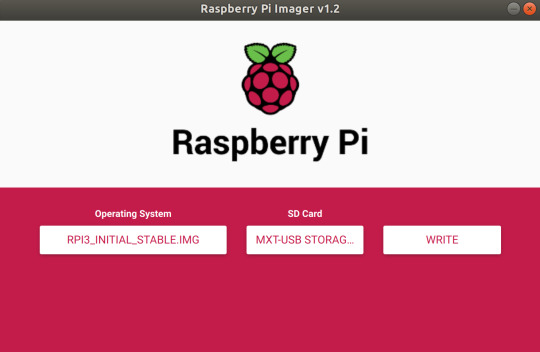
Step 2: Boot your RPI3
a) Insert your sd card and supply the power

Step 3: Detect & Claim your device
a) Connect a LAN cable between your RPI3 & computer/Router.
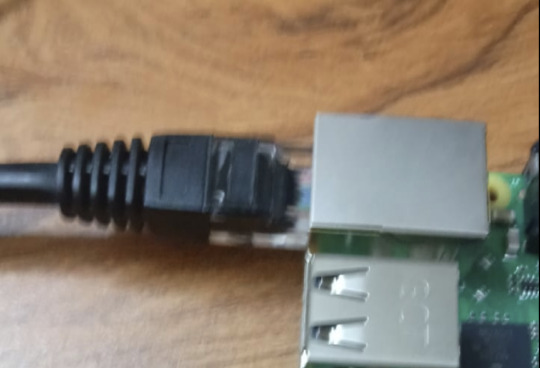
b) Open your terminal & run $pvr scan

c) Claim your device
$ pvr claim -c grossly-pleasant-polliwog https://api.pantahub.com:443/devices/5f0316884f8811000a191ab3

d) Log into Panthub.com and check whether the newly claimed device appeared in the dashboard or not.

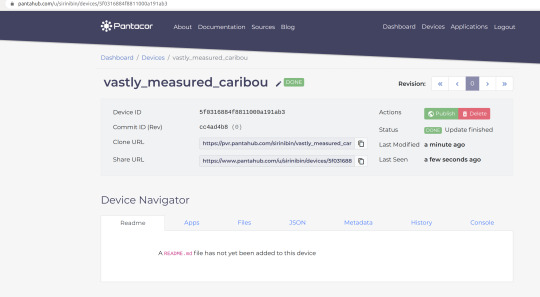
Step 4: Clone the device to your computer
$ pvr clone https://pvr.pantahub.com/sirinibin/vastly_measured_caribou/0 vastly_measured_caribou

Step 5: Add a new app named “apache-php” & Deploy to the device
a) Move to device root dir
`$ cd vastly_measured_caribou`
b) Add new app “apache-php” into the device
$ pvr app add apache-php --from=arm32v7/php:7.2-apache
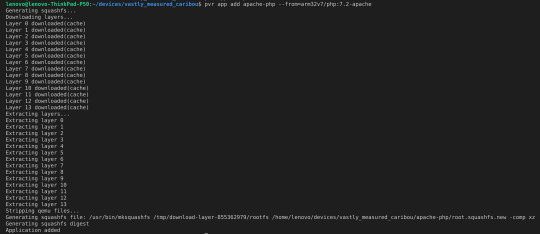
c) Deploy the changes to the device
$ pvr add . $ pvr commit $ pvr post

d) Check the device status changes in Pantahub.com dashboard & wait for the status to become "DONE"
Status 1:

Status 2:

Status 3:

Status 4:

e) Verify the “apache-php” installation
Access the device IP: http://10.42.0.231 in your web browser.

Now you can see that the Apache server is started serving on port 80 in your RPI3 device. But it is showing as “Forbidden” because there is nothing to serve.
Step 6: Serve a php script using the newly installed apache2.4 server
a) Add your ssh key to your device user meta data using pantahub.com dashboard
Note: the key name you should use is pvr-sdk.authorized_keys

b) SSH to the newly created app container “apache-php”
$ ssh -p 8222 [email protected]

c) Install vim editor
$ apt-get update $ apt-get install vim
d) Place a PHP script index.php inside the apache Document Root folder
$ cd /var/www/html $ vim index.php <?php phpinfo() ?>
e) Access your device IP: http://10.42.0.231/ in your web browser
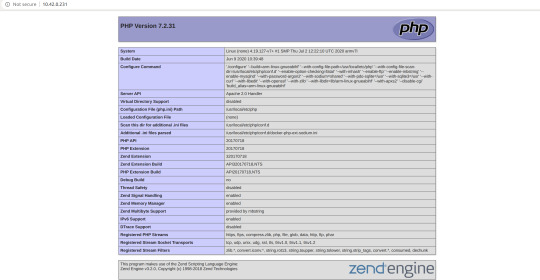
Step 7: Add “mysql” app to the device & deploy the change
a) Add “mysql” app
$ pvr app add mysql --from=yobasystems/alpine-mariadb:arm32v7 --config-json=<(echo -n -e '{ "Env": [ "PATH=/usr/local/sbin:/usr/local/bin:/usr/sbin:/usr/bin:/sbin:/bin", "MYSQL_DATABASE=testdb", "MYSQL_USER=testuser", "MYSQL_PASSWORD=123", "MYSQL_ROOT_PASSWORD=123", "MYSQL_CHARSET=utf8", "MYSQL_COLLATION=utf8_general_ci" ] }')

b) Deploy the changes
$ pvr add . $ pvr commit $ pvr post

Step 8: Add “adminer” app to the device for managing the mysql database
Adminer is a dashboard app which can be used to visually manage the mysql database
By default Adminer will be server through port 8080
a) Add “adminer” app
pvr app add adminer --from=arm32v7/adminer
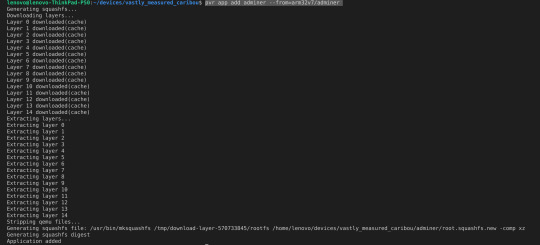
b) Deploy the changes
$ pvr add . $ pvr commit $ pvr post

c) Access the Adminer dashboard by using http://10.42.0.231:8080/
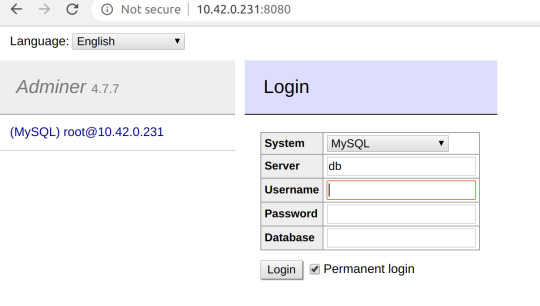
d) Log into the Adminer dasdhboard by entering the below mysql credentials
Server:10.42.0.231 Username:root Password:123
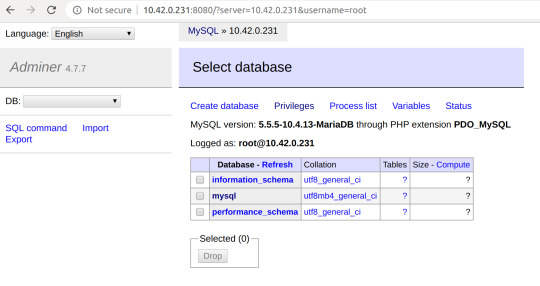
Now you can easily Create/update/delete mysql databases/tables through Adminer
Now you can deploy your custom LAMP app source code into the dir: /var/www/html of docker image:arm32v7/php:7.2-apache and update docker image tag in src.json then run
pvr app update apache-php --from=arm32v7/php:<NewTag>
1 note
·
View note
Text
golang + mysql でホットリロード
環境
docker-compose 3.5
containers
golang: 1.14
mysql: 5.7
ファイル構成
最終的にこういう感じになる。
golang-project ├── binary │ └── app ├── cmd │ └── main.go ├── docker │ ├── go │ │ └── Dockerfile │ └── mysql │ ├── init.d │ │ └── ddl.sql │ └── my.cnf ├── docker-compose.yml ├── .realize.yaml ├── go.mod └── go.sum
ファイル内容
// gomodを単発で取得する $ docker run -v `pwd`:/go/src/app -w /go/src/app golang:1.14 go mod init app
# docker-compose.yml version: '3.5' services: api: depends_on: - db build: context: . dockerfile: ./docker/go/Dockerfile target: build container_name: sample_api environment: MYSQL_USER: worker MYSQL_PASSWORD: password MYSQL_DATABASE: sample MYSQL_HOST: db MYSQL_PORT: 3306 volumes: - .:/go/src/app ports: - 8080:8080 restart: always command: realize start db: image: mysql:5.7 container_name: sample_db environment: MYSQL_ROOT_PASSWORD: root MYSQL_DATABASE: sample MYSQL_USER: worker MYSQL_PASSWORD: password TZ: 'Asia/Tokyo' command: mysqld --character-set-server=utf8mb4 --collation-server=utf8mb4_unicode_ci volumes: # この辺は必要なら適宜 - ./docker/mysql/data:/var/lib/mysql - ./docker/mysql/my.cnf:/etc/mysql/conf.d/my.cnf - ./docker/mysql/init.d:/docker-entrypoint-initdb.d ports: - 3306:3306 restart: always
# docker/go/Dockerfile FROM golang:1.14-alpine as build WORKDIR /go/src/app ADD . . # realizeはgomodに対応していないらしい RUN apk update \ && apk add git \ && GO111MODULE=off go get github.com/oxequa/realize \ && go get -v ./... \ && go build -o ./binary/app ./cmd FROM alpine WORKDIR /app COPY --from=build /go/src/app . RUN addgroup go \ && adduser -D -G go go \ && chown -R go:go /app/app CMD ["./app"]
# .realize.yaml # 基本的に自動生成されるconfigと同じ. commandsのみことなる # 拡張子は、必ず yaml にする。(ymlだと適用されないっぽい) settings: legacy: force: false interval: 0s schema: - name: api path: . commands: install: status: true method: go build -o ./binary/app ./cmd run: status: true method: ./binary/app watcher: extensions: - go paths: - / ignored_paths: - .git - .realize - vendor
realize について
go get でエラーを起こした
go.mod利用して、かつ、GO111MODULE=onの状態でrealizeをgo getすると、以下エラーを吐かれる。
go: github.com/oxequa/realize imports gopkg.in/urfave/cli.v2: gopkg.in/urfave/[email protected]: parsing go.mod: module declares its path as: github.com/urfave/cli/v2 but was required as: gopkg.in/urfave/cli.v2 ERROR: Service 'api' failed to build: The command '/bin/sh -c go get github.com/oxequa/realize' returned a non-zero code: 1 make: *** [env-up] Error 1
関連のissueを読んだ気がするが、解決せんかった。
で、qiitaでgo modにそもそも対応してないぜ、みたいな記事を見た...どこだっけ...
インストールについては、以下みたいに別でやっちゃう方法もありそう?
// apline使った時はapkでパッケージ管理 RUN apk add --no-cache git \ && go get gopkg.in/urfave/cli.v2@master \ && go get github.com/oxequa/realize
参考はここ
最終的には、GO111MODULE=off go getにしてインストールした。 今回の場合はこれでも問題なかったので。GOPATH以下以外でこれをやろうとすると問題起きそう。
realize start が使えない
インストールされたが、realize startが使えなかった。というかうまく動作しなかった。
詳細に書くと、docker-compose.services.api.commandがrealize start --path="./cmd" --run --no-configだったときに動かなかった。
以下なエラーが吐かれます。
sample_api | [13:10:01][APP] : Watching 1 file/s 6 folder/s sample_api | [13:10:01][APP] : Install started sample_api | [13:10:01][APP] : Install sample_api | exec: not started
一応コンテナに入って確認すると、realizeコマンド自体はちゃんと入っていることが確認できた。
ここは、oxequa/realize/issues/217で解決。
--no-configを取っ払って、.realize.yaml(config)を作成。 以下が自動生成されるconfig
# .realize.yaml settings: legacy: force: false interval: 0s schema: - name: app path: . commands: run: status: true watcher: extensions: - go paths: - / ignored_paths: - .git - .realize - vendor
commands部分を編集
commands: install: status: true method: go build -o ./binary/api ./cmd run: status: true method: ./binary/api
最終的に、.realize.yaml(config)を新たに作成し、docker-compose.services.api.commandが、realize startだけになった。
小言
コンテナイメージだけど、golang-alpineでもよかったかなと思い始めている。
2020/08/19 goのイメージをalpineに修正した。マルチステージビルドに修正して、targetで絞っておる。
参考
https://github.com/oxequa/realize
https://qiita.com/y-ohgi/items/671de11f094f72a058b1
http://psychedelicnekopunch.com/archives/1723
https://github.com/oxequa/realize/issues/217
0 notes
Text
さまざまな機能追加が活発に行われているDockerのswarmモード
from http://knowledge.sakura.ad.jp/knowledge/11072/
最近Dockerが力を入れている機能の1つが、Dockerクラスタ環境を構築・運用するための機能であるswarmモードだ。本記事ではDocker 1.13以降で追加されたswarmモード関連の機能を紹介する。
記事前編では、Dockerの開発体制の変化や最近追加された新機能について紹介した。続いて今回は、最近機能強化が続いているDockerの「swarmモード」関連の新機能について紹介していこう。
Dockerの普及により、複数のマシンを組み合わせたクラスタ環境でDockerを利用してサービスを提供する構成が検討されるようになった。Dockerクラスタ構築を支援するKubernetesやCoreOSといったソフトウェアも登場している。Docker自体も、クラスタ構築ツールである「Docker Swarm」を提供していたが、Docker 1.12ではこの機能の一部がDocker本体に「swarmモード」として組み込まれた。これにより、追加のソフトウェアをインストール/設定することなしに、Docker本体だけでDockerクラスタを構築し、複数台のマシン上のDockerデーモンを連携させて容易にコンテナを分散稼動させたり、冗長性のある構成でのサービス運用が行えるようになっている(図1)。
図1 Dockerだけでクラスタを構成できるswarmモード
swarmモードの概要
Dockerのswarmモードは、「manager」ノードと「worker」ノードから構成される。managerノードはクラスタを管理するノードで、workerノードはコンテナを稼働させるノードだ。managerノードはworkerノードを兼ねることもできるので、1つのマシンだけでswarmモードを利用することも可能だ。
swarmモードを使ってクラスタを構成するには、まずmanagerノードで「docker swarm init」コマンドを実行してマネージャーを稼働させる。このとき、マシンに複数IPアドレスが割り当てられている場合は「–advertise-addr <IPアドレス>」オプションでほかのノードと通信するために使用するIPアドレスを指定する必要がある。
たとえば「192.168.1.10」というIPアドレスを使用する場合、次のようになる。
# docker swarm init --advertise-addr 192.168.1.10 Swarm initialized: current node (7aquw76ng1tbpll9yrya8d3ge) is now a manager. To add a worker to this swarm, run the following command: docker swarm join --token SWMTKN-1-40oas1mo53i4o172j3mokf3b67d2al9cqcnh5lyhw12togq7if-923xulrntakv3k3et4kkwrzrg 192.168.1.10:2377 To add a manager to this swarm, run 'docker swarm join-token manager' and follow the instructions.
docker swarm initコマンドを実行すると、クラスタに加入するためのコマンドおよびその引数がが表示されるので、これをworkerノード上でそのまま実行するだけでクラスタ内にノードを追加できる。たとえば上記の例の場合、次のようなコマンドをworkerノード上で実行する。
# docker swarm join --token SWMTKN-1-40oas1mo53i4o172j3mokf3b67d2al9cqcnh5lyhw12togq7if-923xulrntakv3k3et4kkwrzrg 192.168.1.10:2377 This node joined a swarm as a worker.
なお、swarmモードでは下記のポートを利用するので、ノード同士がこれらのポートにアクセスできるようファイアウォールの設定を行っておく必要がある。
2377/tcp 7946/tcp 7946/udp 4789/tcp 4789/udp
たとえばfirewalldを利用している場合、次のように実行することで一時的にこれらのポートを開放できる。
# for p in 2377/tcp 7946/tcp 7946/udp 4789/tcp 4789/udp; do firewall-cmd --zone=public --add-port $p;done
クラスタで稼働しているノードは、docker node lsコマンドで確認できる。次の例では、managerノードに加えて2つのworkerノードが稼働していることを確認できる。
# docker node ls ID HOSTNAME STATUS AVAILABILITY MANAGER STATUS 68p32lyf31fz46kku2r91noq4 centos02 Ready Active 7aquw76ng1tbpll9yrya8d3ge * fedora25 Ready Active Leader k9sxalugwyl9dvpj15yyym1cv centos01 Ready Active
swarmモードでは、「サービス(service)」という単位でコンテナの管理を行う。たとえばクラスタ上でコンテナを稼働させるには、docker service createコマンドを使用する。次の例は、「httpd」コンテナをクラスタ上で稼働させる例だ。ここで、「–replicas」はクラスタ内で稼働させるコンテナ数を指定するオプション、「–name」オプションはそのサービスを参照するための名前を指定するオプションだ。
# docker service create --replicas 1 --name httpd-test httpd
作成したサービスはdocker service lsコマンドで確認できる。
# docker service ls ID NAME MODE REPLICAS IMAGE PORTS ad3mz54z3v4i httpd-test replicated 1/1 httpd:latest
稼働しているサービスは、docker service rmコマンドで削除できる。
# docker service rm httpd-test
このほかswarmモードではレプリカ数の動的変更やコンテナのローリングアップデートといった機能も用意されている。詳しくは、公式ドキュメントのSwarm mode overviewを参照して欲しい。
デプロイ機能の強化
さて、Dockerではサービス提供に必要なコンテナの情報をファイルに記述し、その設定ファイルを元にコンテナを起動・設定する「Docker Compose」というツールが用意されている。Docker Composeについては、以前の記事(複数のDockerコンテナを自動で立ち上げる構成管理ツール「Docker Compose」)で紹介しているので、詳しくはそちらを参照して欲しいのだが、Docker 1.13ではDocker Composerの設定ファイル(composeファイル)を利用して、swarmモードを使って立ち上げたDockerクラウド上にコンテナをデプロイすることが可能になった。この機能は、「docker stack」コマンドから利用できる。
また、この機能の導入とともに、composeファイルの書式も拡張され、新たに「deploy」という設定セクションが追加された。必要に応じて設定を追加・修正した上で、swarmクラスタを構築した環境で次のように「docker stack deploy」コマンドを実行することで、クラスタ内でサービスを起動できる。
$ docker stack deploy <スタック名> --compose-file <composeファイル>
「docker stack」コマンドでは、「スタック」という単位でサービスを管理する。スタック名はそれらを識別するための名称で、任意のものが利用可能だ。
たとえば、次のcomposeファイル(今回は「wp-blog.yml」というファイル名とした)は、MySQLが稼働するmysqlコンテナと、WordPressが稼働するwordpressコンテナについて定義したものだ。
version: '3' services: mysql: image: mysql:5.7 environment: MYSQL_ROOT_PASSWORD: some_password MYSQL_DATABASE: wordpress MYSQL_USER: wordpress MYSQL_PASSWORD: wordpress_password wordpress: image: wordpress:4.5-apache environment: WORDPRESS_DB_USER: wordpress WORDPRESS_DB_PASSWORD: wordpress_password WORDPRESS_DB_NAME: wordpress ports: - 80:80
swarmモードで利用するcomposeファイルはバージョン3以降である必要があるため、「version」の部分を「3」に設定し、それ以外にも一部の値を変更しているが、このファイルは基本的には以前の記事で紹介したものと同一だ(バージョン番号については後述する)。
このファイルからクラスタにコンテナをデプロイする場合、次のように実行する。
# docker stack deploy wp-blog --compose-file wp-blog.yml Creating network wp-blog_default Creating service wp-blog_mysql Creating service wp-blog_wordpress
作成されているスタックは「docker stack ls」コマンドで確認できる。
# docker stack ls NAME SERVICES wp-blog 2
また、各スタックで稼動中のサービスやコンテナは「docker stack services <スタック名>」や「docker stack ps <スタック名>」で確認できる。
# docker stack services wp-blog ID NAME MODE REPLICAS IMAGE PORTS 2upz2n0b7l76 wp-blog_mysql replicated 1/1 mysql:5.7 w58rurzrccs6 wp-blog_wordpress replicated 1/1 wordpress:4.5-apache *:80->80/tcp
さらに、「docker stack ps <スタック名>」でどのコンテナがどのノード上で動いているかも確認できる。
# docker stack ps wp-blog ID NAME IMAGE NODE DESIRED STATE CURRENT STATE ERROR PORTS mtqtlmj77rl6 wp-blog_wordpress.1 wordpress:4.5-apache centos01 Running Running 2 minutes ago ddhn4n1vjzij wp-blog_mysql.1 mysql:5.7 fedora25 Running Running 2 minutes ago
なお、今回はホストの80番ポート経由でwordpressコンテナの80番ポートにアクセスできるよう設定している。swarmモードでは公開設定されたポートへのアクセスを自動的に適切なノードに転送する機能が提供されているので、たとえば今回の例では、「http://192.168.1.10/」「http://192.168.1.100/」「http://192.168.1.101/」のいずれでもwordpressコンテナにアクセスが可能だ。
スタックの削除は「docker stack rm」コマンドで行える(ドキュメント)。
# docker stack rm wp-blog Removing service wp-blog_mysql Removing service wp-blog_wordpress Removing network wp-blog_default
そのほかのswarmモード関連新機能
swarmモード関連の改善としてはそのほか、Docker 17.05でサービスのアップデートやロールバックを行う際に稼動中のコンテナを停止させてから新しいコンテナを立ち上げるか、それとも新しいコンテナを立ち上げてから稼動中のコンテナを停止させるのかを指定する「–update-order」や「–rollback-order」オプションが「docker service create」や「docker service update」コマンドに追加された。
さらに、Dockerfile中で指定された「ENTRYPOINT」を上書きして別のものを使用できるようにする「–entrypoint」オプションの導入や、「docer service update」コマンドにネットワークの追加/削除を行う「–network-add」および「–network-rm」オプションが追加されるといった機能追加も行われている。
Docker Composeファイルのアップデート
docker stackコマンドでDocker Composeの設定ファイルが利用できるようになったことに伴い、この設定ファイルのフォーマットもアップデートされている。
Composeファイルでは、ファイル内にバージョンを記述することで互換性を保つような仕組みになっている。現在の最新バージョンは3.3で、これはDocker 17.06以降で利用が可能だ。ちなみに3.0はDocker 1.13以降、2.0はDocker 1.10以降で利用できる。バージョン間の違いについてはドキュメントにもまとめられているが、バージョン1は「volumes」や「networks」、ビルド引数の設定機能がない。また、Docker Composer 1.6までのサポートとなっており、これ以降のバージョンではサポートされない可能性があるという。バージョン2ではバージョン1から大きく構造が変わっているため、現在バージョン1の設定ファイルを利用している場合、バージョン2の設定ファイルに早めに移行するほうが良いかもしれない。
バージョン2では「services」というキーが導入され、コンテナ関連の設定はこのキー以下に記述するようになった。また、ボリュームやネットワーク関連の設定を記述する「volumes」や「networks」などのキーも導入されている。
バージョン3ではswarmモードでのサポートを加えた一方、いくつかのオプションが削除され、またswarmモードでのデプロイ設定を記述する「deploy」キーが導入されている。
機密情報をコンテナに安全に受け渡す「docker secret」
Docker 1.13では、swarmモードでのみ利用できる機能として「Docker Secrets Management」という機能が導入された。
Dockerを使ってサービスを立ち上げる場合、パスワードや秘密鍵、証明書といったセキュリティに関わる情報はコンテナ内には格納せず、コンテナの起動時に外部から投入することが推奨される。単独のマシン上でコンテナを実行するのであれば、たとえばローカルのファイルをコンテナ内にマウントしたり、コンテナ起動時のオプション経由で機密情報を受け渡すことは容易だ��、複数のマシンを使ったクラスタ環境ではこういった処理を行うために多少の工夫が必要となっていた。
Docker Secrets Managementでは、「docker secret」コマンドで機密情報の登録や管理などを行う仕組みになっている(ドキュメント)。たとえば「docker secret create <名称> <ファイル>」コマンドでは、指定したファイルの内容を指定した名称でシステムに登録できる。
登録された機密情報は、「docker service create」コマンドによるswarmモードでのサービスの起動時に明示的に使用する機密情報を「–secret=<名称>」オプションで指定することで、そのコンテナの「run/secrets/」ディレクトリ内にマウントされ利用可能になる。
設定ファイルなどを共有するための「docker config」
Docker 17.06では、設定ファイルをコンテナ内プロセスに渡すための機能も導入された。これらはDocker Secrets Managementと同様swarmモードでのみ利用可能で、あらかじめ登録しておいたファイルをコンテナ内の任意の場所にマウントできるというものになっている(ドキュメント)。
この機能は、「docker config」コマンド経由で操作が可能だ(ドキュメント)。まず「docker config create <名称> <ファイル>」コマンドで利用したいファイルを登録し、「docker service create」コマンドによるコンテナ起動時に「–config src=<名称>,target=<マウントパス>」オプションを追加することで、コンテナ内で指定した設定ファイルが指定したパスにマウントされる。
Dockerの実験的な機能
最後に、「実験的」(experimental)機能についても紹介しておこう。
Dockerでは、まずは実験的機能として新規機能を実装するケースがある。以前は実験的機能を利用するためにはDockerのビルド時に設定を行う必要があったが、Docker 1.13以降ではDockerが配布するバイナリにも実験的機能が組み込まれるようになり、Dockerデーモンの起動時に「–experimental」オプションを追加することでバイナリを独自ビルドすることなしに実験的な機能を利用できるようになった。
実験的機能が有効になっているかどうかは、「docker version」コマンドを実行で確認できる。「Experimental」が「true」となっていれば実験的機能が有効になっている。
# docker version Client: Version: 17.06.2-ce API version: 1.30 Go version: go1.8.3 Git commit: cec0b72 Built: Tue Sep 5 19:59:06 2017 OS/Arch: linux/amd64 Server: Version: 17.06.2-ce API version: 1.30 (minimum version 1.12) Go version: go1.8.3 Git commit: cec0b72 Built: Tue Sep 5 20:00:25 2017 OS/Arch: linux/amd64 Experimental: true
systemdでDockerデーモンを起動している場合、実験的機能を有効にするには次のような手順を踏めばよい。まず次のようにsystemdの設定ファイル「/lib/systemd/system/docker.service」を/etc/systemd/systemディレクトリ以下にコピーする。
# cp -i /lib/systemd/system/docker.service /etc/systemd/system
続いて、コピーした設定ファイル中の「ExecStart」行に「–experimental」オプションを追加する。
: [Service] Type=notify # the default is not to use systemd for cgroups because the delegate issues still # exists and systemd currently does not support the cgroup feature set required # for containers run by docker ExecStart=/usr/bin/dockerd --experimental ExecReload=/bin/kill -s HUP $MAINPID :
最後に「systemctl daemon-reload」コマンドを実行してsystemd設定ファイルの再読込を行い、続いてdockerデーモンをリスタートすればDockerで実験的機能が利用可能になる。
# systemctl daemon-reload $ systemstl restart docker
チェックポイント機能の導入
現在Dockerではいくつか実験的機能が導入されているが、最近導入された大きな実験的機能として「チェックポイント」機能がある。これは、稼動中コンテナの状態を一時的に記録する「チェックポイント」を作成・管理する機能だ。VirtualBoxやVMwareなどの仮想化ソフトウェアは、稼動中の仮想マシンの状態をストレージに保存して仮想マシンを一時停止させたり、任意のタイミングで再開する機能があるが、Dockerのチェックポイントもこれと同様の機能となる。
チェックポイントの作成は、「docker checkpoint create」コマンドで行える(ドキュメント)。作成されたチェックポイントの一覧は「docker checkpoint ls」コマンド、チェックポイントの削除は「docker checkpoint rm」コマンドで行える。
また、チェックポイントからのコンテナの復元は「docker start」コマンドを「–checkpoint」オプション付きで実行することで行える。
この機能はDocker 1.13で実験的機能(experimental)という位置付けで導入されており、Docker 17.06でもまだ実験的機能のままだ。そのため、デフォルトの設定では利用できないので注意したい。
「Moby」ベースや「Docker CE」になっても方向性に大きな変更はなし
さて、本記事では最近のDockerの状況や新機能について紹介してきた。商用版である「Docker EE」の登場や、コア部分の「Moby」プロジェクトへの移行という大きなトピックはあったものの、Docker自体の機能強化については順調に進んでおり、無償でのDockerの利用についても現時点では特に制限されることはない状況となっている。ひとまず、しばらくは安心してDockerを利用できる状況と言えるだろう。
http://knowledge.sakura.ad.jp/wordpress/wp-content/uploads/2017/09/swarm_mode-440x264.png
0 notes
Photo

Get Started With CRUD Operations in PHP MySQL Databases
In this article, we're going to explore how you could use a MySQL database to perform CRUD (create, read, update, and delete) operations with PHP. If you want to get your hands dirty with database connectivity in PHP, this article is a great starting point.
If you are just getting started with PHP, you probably realize that database connectivity is an essential feature that you'll need to get familiar with sooner or later. In most cases, a database is the backbone of any web application and holds the data of the application. So, as a PHP developer, you'll need to know how to deal with database operations.
In this article, we'll keep things simple and explore how to use the core mysqli functions. In upcoming articles of this series, we'll explore a couple of other ways to handle database connectivity.
Today, we'll go through the basics of database connectivity in PHP, and we'll use the MySQL database as our database back-end. Let's have a quick look at what we'll cover in this article:
how to set up a database connection
how to select a database
how to insert and update records
how to fetch records
how to delete records
I assume that you've a working installation of PHP and MySQL, and that you're aware of the basics of MySQL. Also, you'll need to make sure that the mysqli extension is enabled in your PHP installation, since we'll use it to do database operations with the MySQL database.
If you are not sure about the mysqli extension, you can check it using the phpinfo() function. In the phpinfo() output, you can check if there's a section titled mysqli. You should also see the MysqlI Support | enabled header if the mysqli extension is enabled.
There's also an easy way to check it using the CLI interface. You can run the following command to list all extensions that are enabled with your PHP set up.
$php -m
It should print a list of extensions, and if it contains the mysqli keyword, the mysqli extension is enabled.
Now that we're set up, let's start creating a database connection.
How to Set Up a Database Connection
In this section, we'll discuss how you can establish a database connection using the mysqli extension.
There are two ways you can use the mysqli extension, procedural and object-oriented, but we'll use the procedural way in this post to keep things simple. If you're curious about the object-oriented syntax, let me know your questions in the comment section and I'll be happy to answer them.
Firstly, let's go through the syntax of the mysqli_connect function which is used to set up a connection with the MySQL back-end.
<?php $connection_obj = mysqli_connect("{MYSQL_HOSTNAME}", "{MYSQL_USERNAME}", "{MYSQL_PASSWORD}", "{MYSQL_DATABASE}"); ?>
The mysqli_connect function takes four arguments and returns the connection object upon successful connection. Let's go through the each argument:
MYSQL_HOSTNAME: This should be replaced with the MySQL server's host-name or IP address. If you're working with the MySQL server in your local system, you can either use localhost or 127.0.0.1.
MYSQL_USERNAME: The username of your MySQL user.
MYSQL_PASSWORD: The password of your MySQL user.
MYSQL_DATABASE: The database that you want to connect to.
Upon successful connection, the $connection_obj contains the connection object. With this, you're ready to run queries against the database which was provided to the MYSQL_DATABASE argument.
On the other hand, if the connection is not successful, we can debug it as shown in the following snippet:
<?php $connection_obj = mysqli_connect("{MYSQL_HOSTNAME}", "{MYSQL_USERNAME}", "{MYSQL_PASSWORD}", "{MYSQL_DATABASE}"); if (!$connection_obj) { echo "Error No: " . mysqli_connect_errno(); echo "Error Description: " . mysqli_connect_error(); exit; } ?>
In the next section, we'll see how you can select a specific database using the connection object.
How to Select a Database
In the previous section, we discussed how to set up a database connection using the mysqli_connect function. In this section, we'll look at how to select a database once the MySQL connection is successful.
Of course, as we've already seen, you can always pass a database in the fourth argument of the mysqli_connect function itself. But, there's also another way you could do this in case you want to change a database after you've connected to MySQL. You can use the mysqli_select_db function to select a database to work with.
Let's revise the example discussed in the previous section to see how it can work.
<?php $connection_obj = mysqli_connect("{MYSQL_HOSTNAME}", "{MYSQL_USERNAME}", "{MYSQL_PASSWORD}"); if (!$connection_obj) { echo "Error No: " . mysqli_connect_errno(); echo "Error Description: " . mysqli_connect_error(); exit; } mysqli_select_db($connection_obj, "{MYSQL_DATABASE}"); ?>
As you can see, we've passed only three arguments in the mysqli_connect function, and that should give us a successful database connection. Instead of passing a database in the fourth argument, we select the database using the mysqli_select_db function.
The mysqli_select_db function takes two arguments: the connection object and the database you want to connect to.
How to Create (Insert) and Update Records
In the previous sections, we discussed how to set up a MySQL connection and select a database to work with. Now, we'll look at how to execute different types of queries against the selected database. First, let's look at how to insert and update records.
If you want to follow along with examples discussed in this article, you'll need to create the following MySQL table in your database. It's the table which we're going to use in all the examples form now on.
CREATE TABLE `employee` ( `id` int(11) NOT NULL AUTO_INCREMENT, `name` varchar(50) COLLATE utf8mb4_unicode_ci NOT NULL, `email` varchar(50) COLLATE utf8mb4_unicode_ci NOT NULL, `phone` varchar(50) COLLATE utf8mb4_unicode_ci NOT NULL, PRIMARY KEY (`id`) ) ENGINE=InnoDB DEFAULT CHARSET=utf8mb4 COLLATE=utf8mb4_unicode_ci;
Executing the above command in your MySQL database should create the employee table.
How to Create Records
To keep things simple, we'll initialize values that need to be inserted into the employee table in the beginning of the script. However, in most of the cases, these would come from user input in the $_POST variables submitted using a form.
<?php $connection_obj = mysqli_connect("{MYSQL_HOSTNAME}", "{MYSQL_USERNAME}", "{MYSQL_PASSWORD}", "{MYSQL_DATABASE}"); if (!$connection_obj) { echo "Error No: " . mysqli_connect_errno(); echo "Error Description: " . mysqli_connect_error(); exit; } // initialize variables for the insert query $name = 'John Smith'; $email = '[email protected]'; $phone = '541-754-1234'; // prepare the insert query $query = "INSERT INTO employee(`name`,`email`, `phone`) VALUES ('". mysqli_real_escape_string($connection_obj, $name) ."','". mysqli_real_escape_string($connection_obj, $email) ."','". mysqli_real_escape_string($connection_obj, $phone) ."')"; // run the insert query mysqli_query($connection_obj, $query); // close the db connection mysqli_close($connection_obj); ?>
In the above script, we've first initialized variables that we’re going to use in the insert query. Next, we've prepared the insert query and assigned it into the $query variable.
It's important to note that we've used the mysqli_real_escape_string function to escape string values that we’re going to use in the insert query. You must use this function when you’re dealing with string values submitted via $_POST variables. This ensures that your users don't inject malicious code into to your database queries.
Finally, we ran the insert query using the mysqli_query function. The mysqli_query function is used to run a query against the active database. To wrap things up, we used the mysqli_close function to close the active connection.
How to Update Records
In the previous section, we discussed how you can insert new records in the MySQL table. In this section, we'll see how you can update a record which already exists in the table.
I assume that there's already a record exists in the employee table, and the id of that record is 1. In the following example, we're going to update a record which has a value of 1 in the id column.
<?php $connection_obj = mysqli_connect("{MYSQL_HOSTNAME}", "{MYSQL_USERNAME}", "{MYSQL_PASSWORD}", "{MYSQL_DATABASE}"); if (!$connection_obj) { echo "Error No: " . mysqli_connect_errno(); echo "Error Description: " . mysqli_connect_error(); exit; } // initialize variables for the insert query $id = 1; $phone = '333-555-4444'; // prepare the insert query $query = "UPDATE employee SET `phone` = '". mysqli_real_escape_string($connection_obj, $phone) ."' WHERE `id` = '". (int) $id ."'"; // run the insert query mysqli_query($connection_obj, $query); // close the db connection mysqli_close($connection_obj); ?>
As you can see in the above example, we want to update the phone column of the employee table where id is 1. This is very similar to the insert query, except that we're using UPDATE instead of INSERT.
How to Retrieve Records
So far, we've discussed how to insert and update records in the MySQL table. In this section, we'll see how to retrieve (fetch) records from the MySQL table.
Take a look at the following example.
<?php $connection_obj = mysqli_connect("{MYSQL_HOSTNAME}", "{MYSQL_USERNAME}", "{MYSQL_PASSWORD}", "{MYSQL_DATABASE}"); if (!$connection_obj) { echo "Error No: " . mysqli_connect_errno(); echo "Error Description: " . mysqli_connect_error(); exit; } // prepare the select query $query = "SELECT * FROM employee"; // execute the select query $result = mysqli_query($connection_obj, $query) or die(mysqli_error($connection_obj)); // run the select query while ($row = mysqli_fetch_array($result, MYSQLI_BOTH)) { echo "ID:" . $row['id'] . "<br/>"; echo "Name:" . $row['name'] . "<br/>"; echo "Phone:" . $row['phone'] . "<br/>"; echo "Email:" . $row['email'] . "<br/>"; echo "<br/>"; } // close the db connection mysqli_close($connection_obj); ?>
The first thing that you need to do in order to fetch records from a database is to execute the select query using the mysqli_query function. Upon successful execution of the select query, the mysqli_query function returns the mysqli result object, and that's what we've stored in the $result variable above.
Next, we iterate over the result set using the mysqli_fetch_array function in a while loop. The mysqli_fetch_array function fetches a single row at a time from the mysqli result set.
The mysqli_fetch_array function takes two arguments—the result object and result type. The result type indicates what type of array will be returned from the mysqli_fetch_array function. It could be numeric, associative or both. It's an optional argument and you can pass one of these three values—MYSQLI_ASSOC, MYSQLI_NUM, or MYSQLI_BOTH. MYSQLI_ASSOC indicates that you want to access columns by their name, and MYSQLI_NUM indicates that you want to access columns by their column number.
If you pass the MYSQLI_NUM value in the second argument of the mysqli_fetch_array function, you can access columns as $row[0], $row[1] and so on. In our case, we've passed the MYSQLI_BOTH value, so we can access columns in both ways. If you want to access only associative values, you can use the mysqli_fetch_assoc function instead.
In the next and last section, we'll see how to delete records from a database.
How to Delete Records
In this section, we'll see how to delete records from a database.
Take a look at the following example.
<?php $connection_obj = mysqli_connect("{MYSQL_HOSTNAME}", "{MYSQL_USERNAME}", "{MYSQL_PASSWORD}", "{MYSQL_DATABASE}"); if (!$connection_obj) { echo "Error No: " . mysqli_connect_errno(); echo "Error Description: " . mysqli_connect_error(); exit; } // initialize variables for the delete query $id = 1; // prepare the insert query $query = "DELETE FROM employee WHERE `id` = '". (int) $id ."'"; // run the delete query mysqli_query($connection_obj, $query); // close the db connection mysqli_close($connection_obj); ?>
As you can see, it works pretty much the same as the insert and update queries. The mysqli_query function executes the DELETE query, and that eventually deletes the record from the employee table.
Conclusion
In this article, we explored how you can use the MySQL database with PHP. This article was intended to provide you with a basic knowledge of MySQL database connectivity in PHP to beginners. We saw how to go from setting up a database connection to executing different types of queries.
Feel free to post your feedback and queries using the feed below.
by Sajal Soni via Envato Tuts+ Code https://ift.tt/2QhD0yM
0 notes
Text
Peachpie - Open Source PHP Compiler to .NET and WordPress under ASP.NET Core
The Peachpie PHP compiler project joined the .NET Foundation this week and I'm trying to get my head around it. PHP in .NET? PHP on .NET? Under .NET? What compiles to what? Why would I want this? How does it work? Does it feel awesome or does it feel gross?
Just drink this in.
C:\Users\scott\Desktop\peachcon> type program.php
<?php
function main()
{
echo "Hello .NET World!";
}
main();
C:\Users\scott\Desktop\peachcon> dotnet run
Hello .NET World!
Just like that. Starting from a .NET SDK (They say 1.1, although I used a 2.0 preview) you just add their templates
dotnet new -i Peachpie.Templates::*
Then dotnet new now shows a bunch of php options.
C:\Users\scott\Desktop\peachcon> dotnet new | find /i "php"
Peachpie console application peachpie-console PHP Console
Peachpie Class library peachpie-classlibrary PHP Library
Peachpie web application peachpie-web PHP Web/Empty
dotnet new peachpie-console for example, then dotnet restore and dotnet run. Boom.
NOTE: I did have to comment out his one line "<Import Project="$(CSharpDesignTimeTargetsPath)" />" in their project file that doesn't work at the command line. It's some hack they did to make things work in Visual Studio but I'm using VS Code. I'm sure it's an alpha-point-in-time thing.
It's really compiling PHP into .NET Intermediate Language!
You can see my string here:
But...why? Here's what they say, and much of it makes sense to me.
Performance: compiled code is fast and also optimized by the .NET Just-in-Time Compiler for your actual system. Additionally, the .NET performance profiler may be used to resolve bottlenecks.
C# Extensibility: plugin functionality can be implemented in a separate C# project and/or PHP plugins may use .NET libraries.
Sourceless distribution: after the compilation, most of the source files are not needed.
Power of .NET: Peachpie allows the compiled WordPress clone to run in a .NET JIT'ted, secure and manageable environment, updated through windows update.
No need to install PHP: Peachpie is a modern compiler platform and runtime distributed as a dependency to your .NET project. It is downloaded automatically on demand as a NuGet package or it can be even deployed standalone together with the compiled application as its library dependency.
PHP does have other VMs/Runtimes that are used (beyond just PHP.exe) but the idea that I could reuse code between PHP and C# is attractive, not to mention the "PHP as dependency" part. Imagine if I have an existing .NET shop or project and now I want to integrate something like WordPress?
PHP under ASP.NET Core
Their Web Sample is even MORE interesting, as they've implemented PHP as ASP.NET Middleware. Check this out. See where they pass in the PHP app as an assembly they compiled?
using Peachpie.Web;
namespace peachweb.Server
{
class Program
{
static void Main(string[] args)
{
var host = new WebHostBuilder()
.UseKestrel()
.UseUrls("http://*:5004/")
.UseStartup<Startup>()
.Build();
host.Run();
}
}
class Startup
{
public void ConfigureServices(IServiceCollection services)
{
// Adds a default in-memory implementation of IDistributedCache.
services.AddDistributedMemoryCache();
services.AddSession(options =>
{
options.IdleTimeout = TimeSpan.FromMinutes(30);
options.CookieHttpOnly = true;
});
}
public void Configure(IApplicationBuilder app)
{
app.UseSession();
app.UsePhp(new PhpRequestOptions(scriptAssemblyName: "peachweb"));
app.UseDefaultFiles();
app.UseStaticFiles();
}
}
}
Interesting, but it's still Hello World. Let's run WordPress under PeachPie (and hence, under .NET). I'll run MySQL in a local Docker container for simplicity:
docker run -e MYSQL_ROOT_PASSWORD=password -e MYSQL_DATABASE=wordpress -p 3306:3306 -d mysql
I downloaded WordPress from here (note they have the "app" bootstrapper" that hosts .NET and then runs WordPress) restore and run.
It's early and it's alpha - so set your expectations appropriately - but it's surprisingly useful and appears to be under active development.
What do you think?
Be sure to explore their resources at http://www.peachpie.io/resources and watch their video of WordPress running on .NET. It's all Open Source, in the .NET Foundation, and the code is up at https://github.com/iolevel/ and you can get started here: http://www.peachpie.io/getstarted
Sponsor: Check out JetBrains Rider: a new cross-platform .NET IDE. Edit, refactor, test and debug ASP.NET, .NET Framework, .NET Core, Xamarin or Unity applications. Learn more and download a 30-day trial!
© 2017 Scott Hanselman. All rights reserved.
0 notes